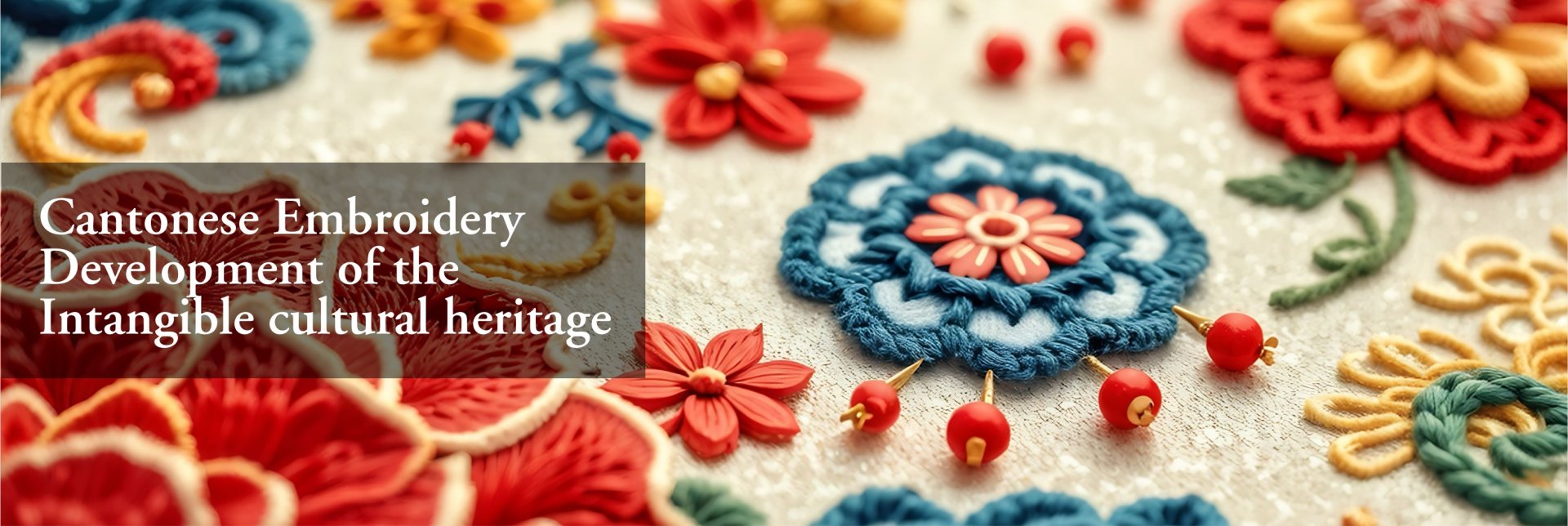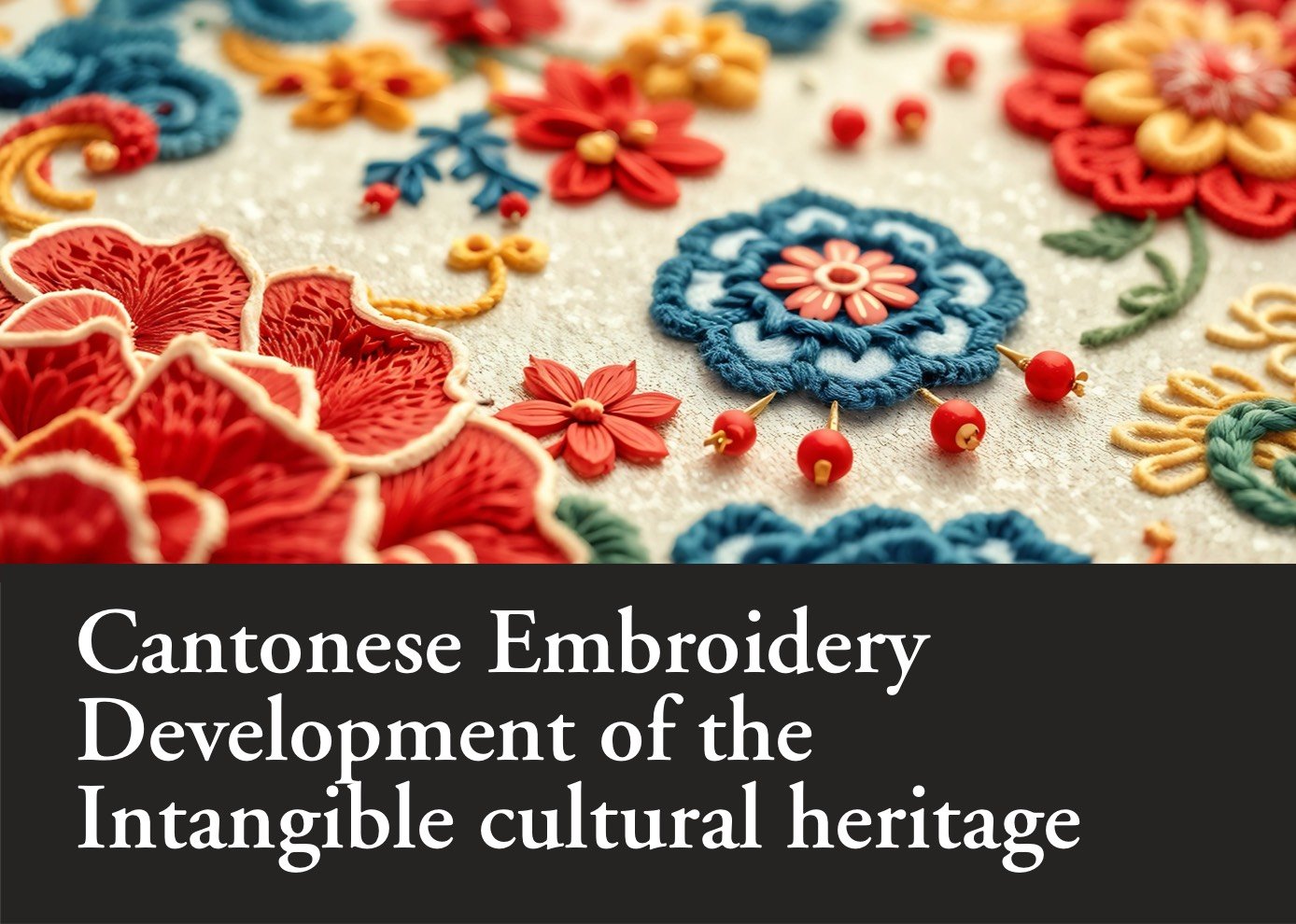Cantonese Embroidery:
Development of the Intangible cultural heritage
Cantonese embroidery (粵繡) is one of the ten famous genres in Chinese embroidery. Cantonese embroidery could be divided into two major subcategories: Guangzhou embroidery (廣繡) and Chaozhou Embroidery (潮繡). Guangzhou embroidery covers embroidery art from areas including Guangzhou (廣州), Shunde (順德), Panyu (番禺) and Nanhai (南海). Chaozhou Embroidery, on the other hand, covers embroidery art from areas including Chaozhou (潮州) and Shantou (汕頭).
History of Cantonese embroidery could be traced to Tang Dynasty (618-907) and reached its golden era in Ming Dynasty (1368-1644) and Qing Dynasty (1644-1911), which has been lasting for more than a thousand years. During the period of late Tang Dynasty and Five Dynasties and Ten Kingdoms (907-979), Guangzhou could escape the damage of warfare, blessed by geographic distant from central and northern China. During this period, Guangdong area saw a big leap forward in development of embroidery, agriculture, and handicraft industries.
The high artistic value of Cantonese embroidery was described in Du-yang memories (杜陽雜記) written by Su Yue (蘇鶚) in the 9th century. It was said that,
“In the first year of the reign of Emperor Shunzong of Tang (唐順宗永貞元年, 805 A.D.), a young girl of fourteen years old came from Nanhai (南海) county called Mei-Niang (眉娘) was sent as a gift to the royal family. She is extremely dexterous. She could embroider the whole seven volumes of The Lotus Sutra of Wondrous Dharma (妙法蓮華經, aka 法華經) on the cloth of one Che (尺) long (around 30cm). The font size is no larger than a tiny grain of millet (粟), yet all the dots and strokes in the character were precisely presented in lines narrower than tiny hairs, without missing any sentences and titles of the original work. She could even divide a single thread into three beams and dye them with five different colours, then wave into five golden layers that depicts ten provinces and three major islands of the country, gods and goddesses and their living places with shapes of phoenix and Kirin, as well as the teenagers who carry the flags and ceremonial sticks were included in the embroidery… Emperor Shunzong of Tang highly regarded her work and granted her the name as Shen Gu (神姑, meaning Goddess like madame).1
There are many varieties in Cantonese embroidery, for example, it could not only be found in ceremonial decorations like banners (條幅), screens (掛屏) and backdrops (台屏), but also be found in household items like quilt covers (被面), pillowcases (枕套), bed covers (床楣), scarves (披巾), headpieces (頭巾), curtains (台帷) and embroidery gowns (繡服), to name a few.
The special feature of Cantonese embroidery is the skilful use of spinning with golden and silver threads. There are a diverse range of skills in needlework; the line patterns are precise and sharp, while the surface is silky and colourful. Cantonese embroidery is also famous for utilizing cultural symbols to illustrate themes of fortune and good wishes. For example, lychee and peacock are common themes. According to Qu Dajun ‘s (屈大均, 1630-1696) New stories from Guangdong (廣東新語) from early Qing dynasty and Zhu Qiqian’s (朱啟鈐, 1872-1964) Category of embroidery of the Cun Su House (存素堂絲繡錄), it was mentioned that since Ming Dynasty, Cantonese embroidery had already adopted peacock feathers for extracting threads in order to add dazzling flares to the final product.
There are three major categories of skills in needling and sowing: basic needlework (基本針法), auxiliary needlework (輔助針法) and iconic needlework (象形針法). To be specific, there are over forty-five different types of skills including straight sewing (直針), continuous sewing (續針), extensive sewing (鋪針) and anchorage sewing (釘針), to name a few.
Cantonese embroidery was world-famous for a long time. As early as in 1600 (the twenty-eighth year of reign of Wanli Emperor of Ming Dynasty, 明萬曆二十八年), Queen Elizabeth I (1533-1603) organized the Embroiderers' Guild to promote embroidery, amazed by the great artistic value of Cantonese embroidery. This act not only illustrated the international influence of Cantonese embroidery, but also paved the way to the development of embroidery industry in the United Kingdom. The Embroiderers' Guild imported Chinese silk and silk threads for tailoring high-ended gowns for British noble classes. King Charles I (1600-1649), who succeeded Queen Elizebeth I, kept on promoting embroidery in the kingdom, in such way Cantonese embroidery was becoming more famous internationally.
In the Qing dynasty, in particular during the time of Qianlong Emperor (乾隆帝, 1711-1799), the development of embroidery in Canton province reached a new height. Many sewing mills and embroidery workshops were established in Guangzhou and Chaozhou areas, which contributed to the bloom of the industry. Cantonese embroidery was exported to United Kingdom and France and other parts of the Europe with vessels, becoming the favourite among royal families and noble classes across Europe.
Therefore, collections of Cantonese embroidery can be found in numerous museums in the UK, France, Germany, and the United States, which reflects the huge artistic value and historical significance of Cantonese embroidery.

References
Books
1. 童芸編著:《刺繡》,黃山書社2014年版,第072頁。
All articles/videos are prohibited from reproducing without the permission of the copyright holder.




Welcome to leave a message:
Please Sign In/Sign Up as a member and leave a message